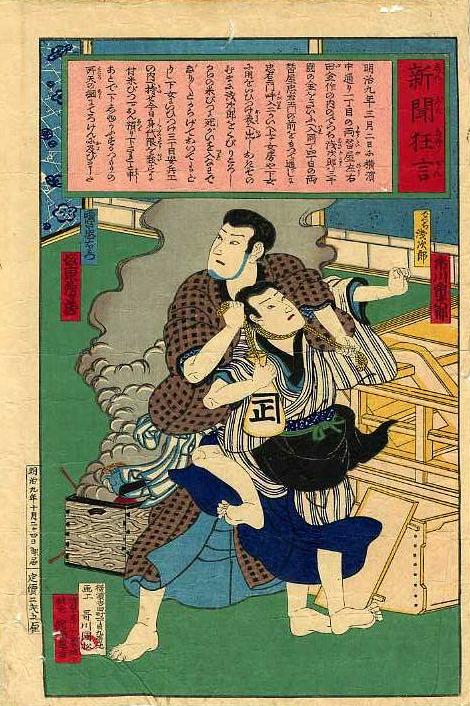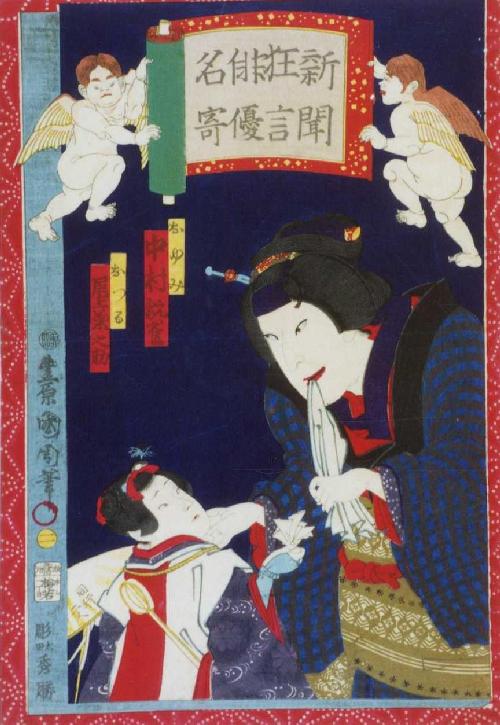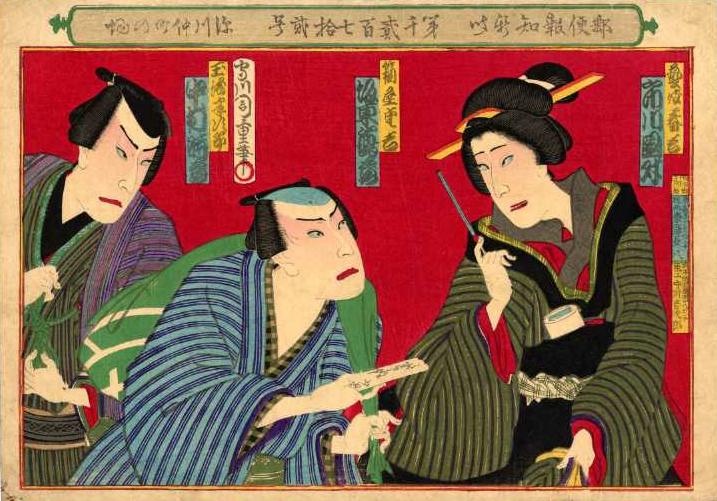Dramatizations of news
News nishikie as primetime theater playguides
By William Wetherall
First posted 1 December 2007
Last updated 20 January 2008
News drama World of artisans | Parameters of "news" | Limitations of scholarship
"News drama" hot and cold
Dramatists everywhere are naturally inclined to draw their stories from actual events and incidents, ancient and contemporary. For the whole purpose of theater -- on stage or screen -- is to pull an audience into a human affair enacted through the dramatist's eye for the tragic, comic, and ironic in life.
Many dramas now regarded as "historical" were first performed when their events were still as fresh as last year's tidings or yesterday's news. Today, all manner of true crimes, acts of heroism, and survival adventures inspire quickie novels and television and theater movies.
In Japan, too, most plays in all genres of theater were inspired by actual events, often very recent if not current. As "news" became fashionable during the late Edo and early Meiji periods, kabuki playwrights reflexively turned to newspapers as sources of raw material.
Though not in any dictionary or art history encyclopedia, "shinbun kyōgen" (新聞狂言) or "news drama" enjoyed some currency during the early Meiji period. The expression is found on at least one 1876 news nishikie about a true crime drama performed that year -- a docudrama meant to entertain as much as inform.
However, not all nishikie that featured "news" and "drama" in their titles were about dramatizations of news. And not all prints that appear to concern dramatizations of news qualify as news nishikie.
Pseudo "news drama"The title of the print to the right begins with the terms "news" (新聞 shinbun) and "drama" (狂言 kyōgen). However, the print is conveying "news" about kabuki (狂言 kyōgen) actors, and the drama in which they are cast -- not about the subject of the drama. Contemporary audiences would have immediately recognized the names and relationship of the two characters shown on this print. Their story is one of the most famous in Japan -- and its origin is a perfect example of how playwrights, before the Meiji period, had mined fresh, stale, and forgotten "news" for nuggets of human drama. Oyumi and OtsuruWaseda University's Tsubouchi Memorial Theatre Museum database says the title of the drama featured on this print was けいせい阿波の鳴戸 (Keisei Awa no Naruto). This could have been guessed from the cast shown on the print, from right to left: Oyumi and Otsuru played by Nakamura Kanjuku and Onoe Kikunosuke. The database also states that the performance shown on the print was performed at the Edo Shintomi theater in Tokyo in June 1875, two months before the date of the approval seal on the print. RESUME Synopsis of "Keisei Awa no Naruto"Hachisuka (蜂須賀), the lord of Awa, has sent Jurobee (十郎兵衛 Jūrōbee) and his wife Oyumi (お弓) to live in Osaka on a secret mission to recover his stolen sword. The couple had to leave their three-year-old daughter, Otsuru (おつる), with her grandmother in Awa. Jurobee, posing as the ronin Ginjuro (銀十郎 Ginjūrō), has joined a band of robbers to find the sword. A number of years pass and Otsuru, now an older girl, goes on a pilgrimage looking for her parents. While singing door to door for alms, she happens upon the dwelling where Jurobee and Oyumi are living. Oyumi hears Otsuru's story and immediately recognizes the girl as her daughter. To reveal this, though, would risk the mission and doom the daughter. But Oyumi treats Otsuru kindly, like a daughter, and Otsuru imagines she is her mother. Otsuyu, continuing on her pilgrimage, passes through a woods. There she encounters Jurobee, who eyes her coin purse. Otsuru resists his attempts to take it, and the rest is pure Oedipal tragedy. From bunraku to kabuki"Keisei Awa no Naruto" (傾城阿波の鳴門) is attributed to Chikamatsu Hanji (近松半二) and Takemoto Saburobee (竹本三郎兵衛), among others. It was first performed, using puppets, at the Takemotoza theater (竹本座) in Osaka in 1768 (Meiwa 5). The full play has ten acts. Most people today see only Act 8 -- "Act of the pilgrim song" (巡礼歌の段 Junreika no dan) -- the subject of the 1875 actor nishikie. Act 8 is so famous it's script is included on the CD-ROM version of the 5th edition of Kōjien, Japan's most widely used desktop dictionary. The pilgrim song act is performed practically everyday on a puppet stage in what is left (and has been restored) of the spacious residence and garden of Bandō Jūrōbee (坂東十郎兵衛). It is one of the most popular tourist attractions in Fukushima city. Most puppet plays were quickly adapted to the kabuki stage. "Keisei Awa no Naruto" remains one of the most popular pieces in the repertoire of both theaters. The real JurobeeThe real Jurobee, born in 1646, did nothing so dramatic as assume the guise of a robber and unknowingly kill his own daughter. Yet what he is said to have actually done is every bit as as tragic as the fate of his legendary doppelganger. The real Jurobee succeeded his father as headman (庄屋 shōya) of the village of Miyajimaura (宮島浦) in Awa, and also oversaw the province's rice. Locally he is celebrated as a hero who saved the province from possible breakup by the Shogunate. In violation of Shogunate orders, Awa was importing rice to make up for shortages. The illegal trade had been sanctioned by the provincial lord. When falsely accused of an offense by a rice importer he had caught profiteering from the trade, Jurobee accepted punishment to prevent an investigation, which would have revealed the trade and endangered the lord and the province. Jurobee, and his three sons, were executed in the manner of common criminals on 22 December 1698 (Genroku 11-11-21). Oyumi and Otsuru are said to have died of illness in exile. Awaji and puppet theaterThe province of Awa (阿波国 Awa no kuni), on the island of Shikoku, is now Tokushima prefecture. In the past it was reached from places like the port of Hyogo (now Kobe) and Osaka via the island of Awaji (淡路), which means "Awa road" in the sense of "way to Awa". Awaji is today part of Hyogo prefecture. It is also, now, the stepping stone for the highway and bridges that link the cities of Kobe in Hyogo prefecture and Naruto in Tokushima prefecture. Awaji boasts of being the cradle of ningyō jōruri (人形浄瑠璃) during the 16th century, and today the island promotes Awa style puppet theater worldwide. Puppet theater also developed in Osaka, where it came to be called bunraku (文楽). |
Fukagawa Nakamachi no baForthcoming. Drawn by Morikawa Otojiro |


